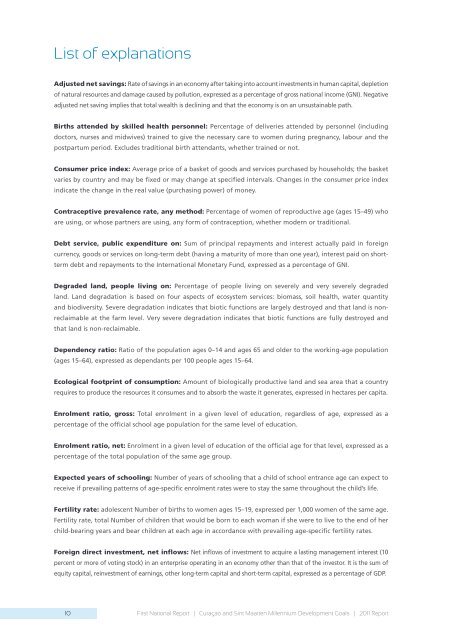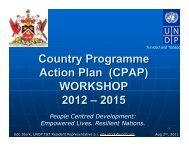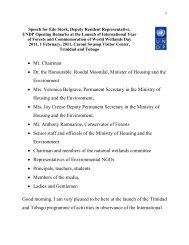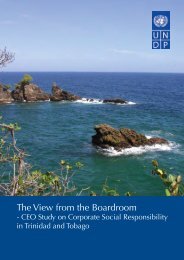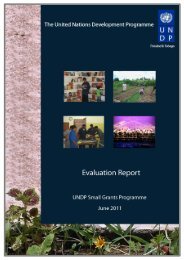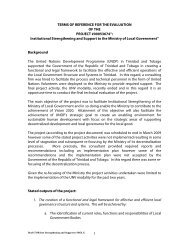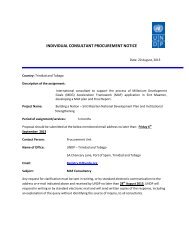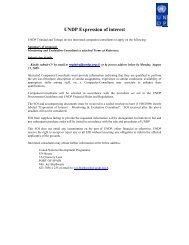Curaçao & Sint Maarten - UNDP Trinidad and Tobago
Curaçao & Sint Maarten - UNDP Trinidad and Tobago
Curaçao & Sint Maarten - UNDP Trinidad and Tobago
Create successful ePaper yourself
Turn your PDF publications into a flip-book with our unique Google optimized e-Paper software.
List of explanations<br />
Adjusted net savings: Rate of savings in an economy after taking into account investments in human capital, depletion<br />
of natural resources <strong>and</strong> damage caused by pollution, expressed as a percentage of gross national income (GNI). Negative<br />
adjusted net saving implies that total wealth is declining <strong>and</strong> that the economy is on an unsustainable path.<br />
Births attended by skilled health personnel: Percentage of deliveries attended by personnel (including<br />
doctors, nurses <strong>and</strong> midwives) trained to give the necessary care to women during pregnancy, labour <strong>and</strong> the<br />
postpartum period. Excludes traditional birth attendants, whether trained or not.<br />
Consumer price index: Average price of a basket of goods <strong>and</strong> services purchased by households; the basket<br />
varies by country <strong>and</strong> may be fixed or may change at specified intervals. Changes in the consumer price index<br />
indicate the change in the real value (purchasing power) of money.<br />
Contraceptive prevalence rate, any method: Percentage of women of reproductive age (ages 15–49) who<br />
are using, or whose partners are using, any form of contraception, whether modern or traditional.<br />
Debt service, public expenditure on: Sum of principal repayments <strong>and</strong> interest actually paid in foreign<br />
currency, goods or services on long-term debt (having a maturity of more than one year), interest paid on shortterm<br />
debt <strong>and</strong> repayments to the International Monetary Fund, expressed as a percentage of GNI.<br />
Degraded l<strong>and</strong>, people living on: Percentage of people living on severely <strong>and</strong> very severely degraded<br />
l<strong>and</strong>. L<strong>and</strong> degradation is based on four aspects of ecosystem services: biomass, soil health, water quantity<br />
<strong>and</strong> biodiversity. Severe degradation indicates that biotic functions are largely destroyed <strong>and</strong> that l<strong>and</strong> is nonreclaimable<br />
at the farm level. Very severe degradation indicates that biotic functions are fully destroyed <strong>and</strong><br />
that l<strong>and</strong> is non-reclaimable.<br />
Dependency ratio: Ratio of the population ages 0–14 <strong>and</strong> ages 65 <strong>and</strong> older to the working-age population<br />
(ages 15–64), expressed as dependants per 100 people ages 15–64.<br />
Ecological footprint of consumption: Amount of biologically productive l<strong>and</strong> <strong>and</strong> sea area that a country<br />
requires to produce the resources it consumes <strong>and</strong> to absorb the waste it generates, expressed in hectares per capita.<br />
Enrolment ratio, gross: Total enrolment in a given level of education, regardless of age, expressed as a<br />
percentage of the official school age population for the same level of education.<br />
Enrolment ratio, net: Enrolment in a given level of education of the official age for that level, expressed as a<br />
percentage of the total population of the same age group.<br />
Expected years of schooling: Number of years of schooling that a child of school entrance age can expect to<br />
receive if prevailing patterns of age-specific enrolment rates were to stay the same throughout the child’s life.<br />
Fertility rate: adolescent Number of births to women ages 15–19, expressed per 1,000 women of the same age.<br />
Fertility rate, total Number of children that would be born to each woman if she were to live to the end of her<br />
child-bearing years <strong>and</strong> bear children at each age in accordance with prevailing age-specific fertility rates.<br />
Foreign direct investment, net inflows: Net inflows of investment to acquire a lasting management interest (10<br />
percent or more of voting stock) in an enterprise operating in an economy other than that of the investor. It is the sum of<br />
equity capital, reinvestment of earnings, other long-term capital <strong>and</strong> short-term capital, expressed as a percentage of GDP.<br />
10 First National Report | <strong>Curaçao</strong> <strong>and</strong> <strong>Sint</strong> <strong>Maarten</strong> Millennium Development Goals | 2011 Report


